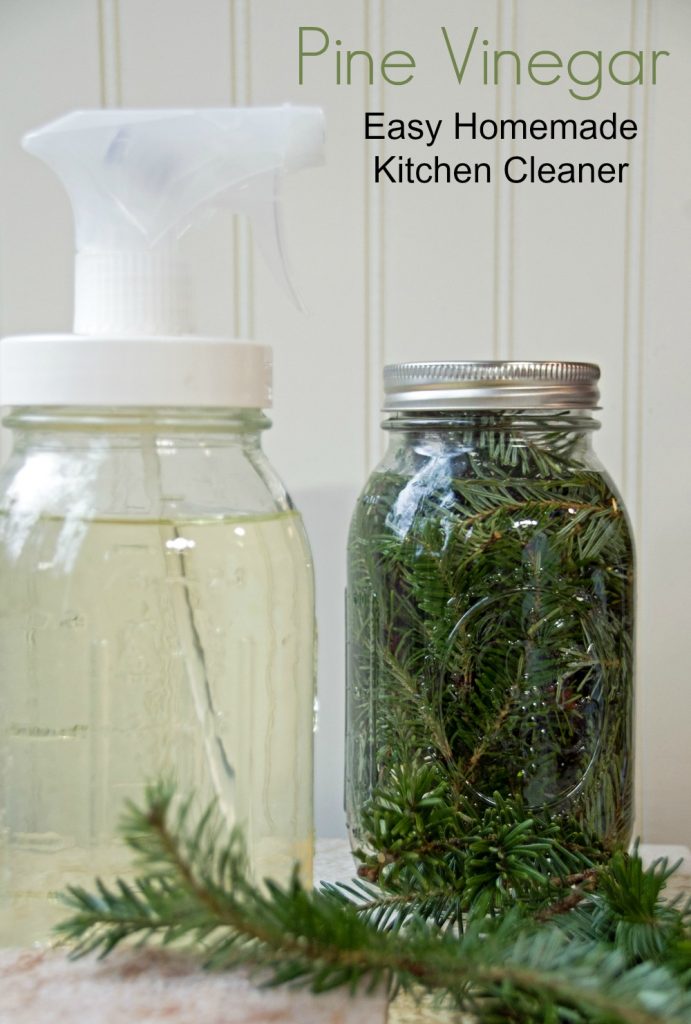With the new year comes a renewed determination to go green, get healthy, and simplify my life. This DIY pine vinegar is an easy homemade kitchen cleaner that I will be keeping right next to my kitchen sink this year.
Since I have pine trees in the back yard, I have an abundant supply of needles and pine cones. If you are looking for creative ways to use what your land provides, make this easy pine vinegar and then check out my suggestions for ways to use pine cones around the house.
Posts feature partner companies & may be sponsored. Post contains affiliate links & I will be compensated if you make a purchase after clicking on links. As an Amazon Associate I earn from qualifying purchases.

Table of Contents
Supplies for Making Pine Vinegar
So, most of what you need can be found in your yard or at your local grocery store. Here are my suggestions for making pine vinegar for cleaning:
- White vinegar: Don’t get fancy and buy the brand name, expensive stuff. Just get a big just of cheap, white vinegar.
- Pine needles and branches: Snip them fresh off the tree for the most scent possible. Your old Christmas tree that has been sitting in your house for 2 weeks is probably not the best choice. You can certainly use it, but it may need to steep longer.
- Pine essential oil: Not required but you can add a few drops of pine essential oil at the end if you want a stronger smell.
- Mason Jar: You will need to let this DIY pine vinegar ‘steep’ for 4 to 6 weeks. A large glass mason jar is the best option for storage. Keep it out of direct sunlight.
- Spray attachment: Once your pine vinegar is ready to use, unscrew the mason jar lid and screw on a mason jar spray adapter .

✯Don’t want to miss the next post?✯
Follow Turning the Clock Back on Facebook | Twitter | Pinterest
Or join the private Facebook group for simple tips on going green!
How to Make Homemade Kitchen Cleaner
Now that you have your supplies, start making your homemade kitchen cleaner.
- Snip your fresh pine branches and pack them tightly into the glass mason jar.
- Cover the pine needles with white vinegar.
- Allow the vinegar to steep for several weeks in a dark cabinet.
- Check after 4 weeks and see if it is strong enough. If not, let sit for another 2 weeks.
- Pour off the pine-scented vinegar, adding a few drops of essential oil if you think the vinegar smell is still too strong.
- To clean, just spray and wipe with a wet sponge!

Making pine vinegar is a great way to save money and reduce your household’s use of toxic cleaners. Homemade kitchen cleaner is generally much safer to use, especially around areas where food preparation happens. Keep this cleaner next to your sink and use it regularly. Check out my DIY sponge dish for more kitchen cleaning inspiration!
Have any other homemade kitchen cleaner recipes you want to share?
Like this DIY Pine Vinegar?
Pin for Later!


Diane is a professional blogger and nationally certified pharmacy technician at Good Pill Pharmacy. She earned her BS in Microbiology at the University of New Hampshire and has worked in cancer research, academics, and biotechnology. Concern over the growing incidence of human disease and the birth of her children led her to begin living a more natural life. She quickly realized that the information she was learning along the way could be beneficial to many others and started blogging and freelance writing to share this knowledge with others. Learn more about her HERE.

Hi Diane,
Do you have a natural recipe for a bathroom deodorizer?
Thanks
Alison
I have not made one yet but sounds like a great project!
When you say pine needles…my mind wonders how specific you’re being.
The varieties are vast.
Does it have to be specific or is it a little like the citrus family? They are good for something.
I think you can probably use a wide variety. Most have very similar qualities, just like citrus fruits are related